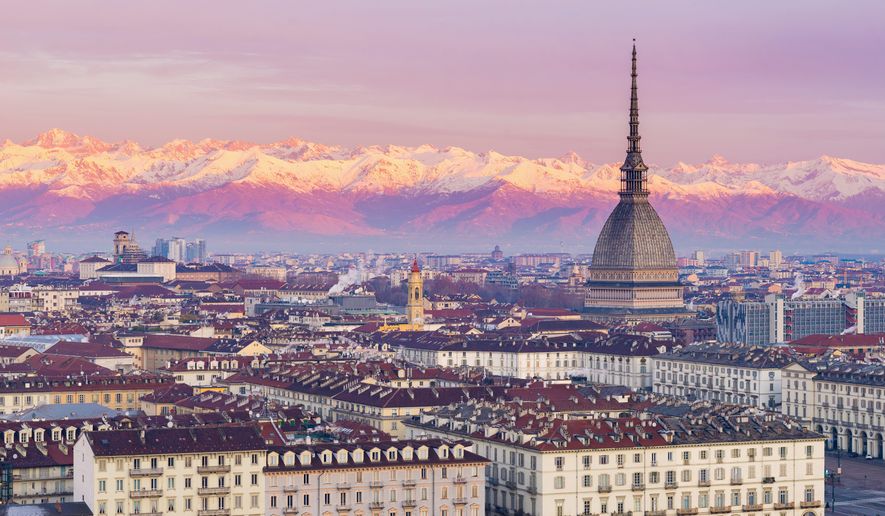OPINION:
What could taste better than white truffles or gianduja chocolates? Both are specialties of Turin, an elegant baroque city, the first capital of a unified Italy, consistently overlooked by tourists. Its center has narrow streets opening onto beautiful squares. It has become Italy’s contemporary, conceptual art center with museums and galleries devoted to the latest in Italian art, while not neglecting Renaissance painting and sculpture.
Turin — Torino in Italian — derives its name from the Celtic word “tau,” meaning mountain. It lies at the foot of the Italian Alps, and on sunny days the snow-capped mountains provide a sparkling backdrop to the city.
Turin was known for most of the 20th century as an industrial city, thanks to Giovanni Agnelli’s Fiat (Fabbrica Italiana Automobile Torino). The avant grade automobile factory, which included a test track on the roof, closed in 1982 and architect Renzo Piano turned it into a hotel, shopping and entertainment center. The roof and long spiral ramp, used in several movies, are intact and open to the public.
The city’s industrial reputation was strengthened by the Olivetti company located in Ivrea, a pretty town known for its 14th century castle, its pre-Lenten festival of oranges (not eaten but thrown at rival teams) and the revolutionary Olivetti typewriter, calculator and computer. Although the Olivetti family no longer owns the factories, they remain part of Ivrea’s landscape along with the housing, school and health center the progressive company built.
At the end of October, Turin welcomes the annual Artissima contemporary art fair when galleries showcase the artists they represent. Turin’s Artissima waa established in 1994 and galleries from around the world participate each year. The fair combines the international art market with a focus on experimentation and research. Turin has an international art book fair (FLAT) offering all types of art publications, old and new, during Artissima.
The first museum in Italy devoted to contemporary art opened in Turin in 1984 in the 18th century Castello di Rivoli, where more than 200 artists are represented, including Richard Long, Sol Lewitt, and Ai Weiwei.
The Fondazione Merz is a center for contemporary art; it hosts exhibitions and art related events. The Fondazione Sandretto Re Rebaudengo is a non-profit institution designed to reflect trends in art, music, dance, literature and design.
The Museo Ettore Fico is part of a restoration plan in an abandoned industrial area of Turin, which also includes many artists’ studios. It features exhibitions, cultural events and workshops with a focus on modern and contemporary art in all its forms.
South of Turin in the town of Reggio Emilia, the Collezione Maramotti of outstanding modern and contemporary art is housed in a former clothing factory. Reggio Emilia’s unusual Tricolor Museum displays the history of Italy’s national flag with objects and paintings from its origins through the Napoleonic period to unification of the country.
Although Turin has become a center for conceptual art, it has many classical museums. Foremost is the Egyptian Museum, the oldest in Europe and second only in importance to the museum in Cairo. It displays not only mummies and sacred animals, but also ornaments and furnishings detailing the lives of the pharaohs and ordinary people.
Turin is known for its many styles of architecture. The 15th century duomo (cathedral) contains a replica of the Turin Shroud, the alleged winding sheet in which the body of Christ was wrapped for burial. The original is not on view. (Carbon tests date the cloth to medieval times.)
The Via Roma, a splendid wide street, dissects the old town, with the large Piazza San Carlo in the middle. The Piazza has two baroque churches and the sides of the square are flanked with stone arcades where elegant shops display their wares, and apartments above overlook the piazza in old fashioned splendor.
Turin is famous for its chocolate, introduced to Spain by Hernan Cortes in the 16th century, and brought to Turin in 1585 via the marriage of the Duke of Savoy to Catherine, the daughter of the king of Spain. During the Napoleonic Wars, when chocolate was in short supply because of an English embargo, hazelnuts were added to the chocolate. In 1865 a Turin chef added ground hazelnuts and gianduiotto was born, named for a character in the Commedia dell’ Arte.
Today, gianduja chocolates are available at chocolate shops throughout Turin as are several other types of chocolates incorporating hazelnuts. Nutella was invented in 1946 in Alba, a nearby city. Other specialties are truffles, agnolotti, vermouth and Barolo wine. Ice cream on a stick, the “pingiuno,” was invented in Turin in 1939.
Turin has a huge daily market, Porta Palazzo, Europe’s largest outdoor market featuring about 800 stalls including a 100 stall farmers’ market. The market sells everything from local fruits and vegetables to second hand clothing on Saturdays when it becomes a flea market as well.
The next time you go to Italy, don’t bypass elegant Turin. Stop, enjoy some interesting art and architecture, and sip a bicerin, the city’s delectable drink of melted chocolate, expresso and cream.
• Corinna Lothar is a Washington writer, critic and frequent contributor to The Washington Times.




Please read our comment policy before commenting.